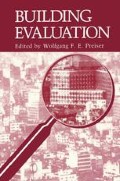Abstract
Post-Occupancy Evaluation is recognized and valued as a process that can improve, and help explain, the performance of the built environment. During the past twenty-five years it has emerged as a distinct area of research, scholarly activity, and application, and work in the field has rapidly expanded — it now encompasses significant activity beyond that found in the standard environment-behavior literature. This chapter examines the evolution of, and contemporary activities in, Post-Occupancy Evaluation (POE), to distinguish patterns in the use and boundaries of POE. Specific attributes of POE activities that are examined include: (1) the intentions of the POE; (2) the type, size and complexity of the buildings investigated; (3) the types of variables that were included in the evaluations; and (4) the relationships among the variables studied.
Access this chapter
Tax calculation will be finalised at checkout
Purchases are for personal use only
Preview
Unable to display preview. Download preview PDF.
References
Baran, B., Ross, J. and Cohen S., 1985, Technological Innovation and Deregulation: The Transformation of the labor process in the Insurance Industry, Berkeley Roundtable on the International Economy, University of California at Berkeley, Berkeley, Calif.
Brill, M. et al, 1984, Using Office Design to Increase Productivity, Vol 1, Workplace Design and Productivity Inc., Buffalo, N.Y.
Building Research Board, 1987, Post-Occupancy Evaluation Practices in the Building Process: Opportunities for Improvement, National Academy Press, Washington D.C.
Francescato, G. et al., 1979, Residents’ Satisfaction in HUD-Assisted Housing: Design and Management Factors, U.S. Department of Housing and Urban Development, U.S. Government Printing Office, Washington D.C.
Goldberg, Michael, 1984, Assessing Land Use Impacts of Transportation Improvements, in: Land-Use Impacts of Highway Projects: Proceedings of the Wisconsin Symposium on the Land-Use Impacts of Highway Projects, Center for Urban Transportation Studies, University of Wisconsin, Milwaukee, April, 1984.
Harvey, J. and Hennings, H. (Eds.), 1987, Environmental Design Research Association, EDRA 18 Conference Proceedings, Environmental Design Research Association, Washington D.C.
International Facility Management Association, 1987, IFMA Facilities Benchmarks, Houston, Texas.
Manning P. (Ed.), 1965, Office Design: A Study of Environment, Pilkington Research Unit, Department of Building Science, University of Liverpool, Liverpool, England.
Markus, T. et al., 1972, Building Performance, Halstead Press, New York.
Marans, R. and Spreckelmeyer, K., 1981, Evaluating Built Environments: A Behavioral Approach, The University of Michigan, Institute for Social Research and the College of Architecture and Urban Planning, Ann Arbor, Michigan.
McLaughlin, H., Kibre, J. and Mort, R., 1972, Patterns of Physical Change in Six Existing Hospitals, in: W. Mitchell (Ed.), Environmental Design: Research and Practice, University of California, Los Angeles.
Newman, O., 1973, Defensible Space: Crime Prevention Through Urban Design, Collier Books, New York.
Preiser, W. F. E., Rabinowitz, H. Z. and White, T., 1988, Pest-Occupancy Evaluation, Van Nostrand Reinhold, New York.
Peters, T., and Waterman, R. Jr., 1982, In Search Of Excellence, Harper and Row, New York.
Van der Ryn S. and Silverstein M., 1967, Dorms at Berkeley, University of California, Center for Planning and Research, Berkeley, Calif.
Wall Street Journal, September 18, 1985, Basic Bedrooms: How Marriott Changes Hotel Design to Tap Mid-Priced Market, Wall Street Journal, New York.
Wener, R., Frazier, W., and Farbstein J., 1985, Three Generations of Evaluation and Design of Correctional Facilities, in: Environment and Behavior, 17:1, M. Kantrowitz, and A. Seidel (Eds.), Sage Publications, Beverly Mils, Calif., Jan. 1985.
Whyte, William H., 1980, The Social Life of Small Urban Spaces, The Conservation Foundation, Washington D.C.
Williams, C., Armstrong, D., and Clark, M., 1985, The Negotiable Environment, Facility Management Institute, Ann Arbor, Michigan.
Zeisel, J., 1975, Sociology and Architectural Design, Russell Sage Foundation, New York.
Author information
Authors and Affiliations
Editor information
Editors and Affiliations
Rights and permissions
Copyright information
© 1989 Springer Science+Business Media New York
About this chapter
Cite this chapter
Rabinowitz, H.Z. (1989). The Uses and Boundaries of Post-Occupancy Evaluation: an Overview. In: Preiser, W.F.E. (eds) Building Evaluation. Springer, Boston, MA. https://doi.org/10.1007/978-1-4899-3722-3_2
Download citation
DOI: https://doi.org/10.1007/978-1-4899-3722-3_2
Publisher Name: Springer, Boston, MA
Print ISBN: 978-1-4899-3724-7
Online ISBN: 978-1-4899-3722-3
eBook Packages: Springer Book Archive

